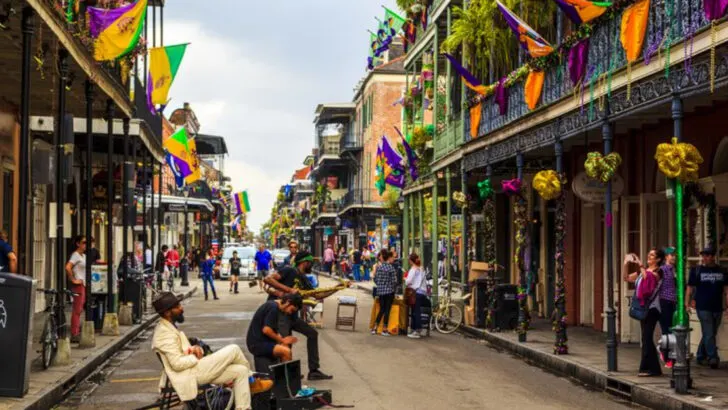Overtourism is becoming a growing concern in some of America’s most beloved cities. From bustling metropolises to charming small towns, these destinations face challenges as they struggle to balance tourism with local quality of life. This blog post highlights 15 cities across the United States that are grappling with the pressures of overtourism, exploring how each unique locale is affected and what makes them special despite the challenges.
Lake Tahoe, California/Nevada
Lake Tahoe is a beloved destination for both summer and winter activities. Its alpine beauty draws crowds year-round, leading to overwhelmed roads and housing issues. The local workforce often struggles with the high cost of living. Lake Tahoe’s pristine waters and surrounding mountains are its greatest assets, yet managing tourism is an ongoing challenge. Fun Fact: Lake Tahoe is the second deepest lake in the United States, following Crater Lake in Oregon.
Honolulu, Hawaii
A tropical paradise, Honolulu is known for its picturesque beaches and cultural sites. It serves as a gateway to the Hawaiian Islands, attracting throngs of visitors year-round. The constant foot traffic threatens its natural resources and cultural heritage. Waikiki Beach is iconic, but its popularity brings development pressures that locals often resist. The challenge lies in preserving its unique beauty while accommodating eager tourists. Fun Fact: Honolulu means ‘sheltered harbor’ or ‘calm port’ in Hawaiian, a fitting name for this island gem.
Asheville, North Carolina
Nestled in the Blue Ridge Mountains, Asheville charms with its art scene and nature trails. It’s a haven for those seeking creativity and tranquility. Yet, the surge in tourism has driven up real estate prices and crowded trails. Its popularity among nature lovers and artists is both a blessing and a challenge. Keeping the delicate balance between attracting visitors and preserving local life is key. Did you know? Asheville was once known as the “Paris of the South” due to its vibrant culture and architecture.
New Orleans, Louisiana
Known for its vibrant culture, jazz music, and rich history, New Orleans is a magnet for global tourists. The French Quarter and Bourbon Street are at the heart of the city’s allure. However, the continuous flow of visitors impacts the local way of life. Short-term rentals and cruise traffic are changing the character of historic neighborhoods, leaving locals feeling the pinch. New Orleans is a blend of tradition and festival spirit, a place where every corner tells a story. Did you know? Jazz was born here, making it a music lover’s paradise.
Sedona, Arizona
Sedona’s stunning red rock formations and mystical aura make it a beloved destination. Once a peaceful retreat, its trails now see heavy traffic, and erosion is a growing concern. Instagram fame has added to the surge, with visitors flocking to capture its beauty. Balancing tourism with preservation is a pressing issue. This desert town is a place of reflection and adventure, attracting both nature enthusiasts and spiritual seekers. Did you know? Sedona is considered a vortex site, believed to have healing energy.
Miami, Florida
With its vibrant nightlife and beautiful beaches, Miami is a year-round hotspot. The city’s unique Art Deco architecture adds to its charm. However, overtourism brings challenges like coastal damage and traffic jams. Locals feel the pressure as housing becomes scarce and expensive. Miami’s allure lies in its diverse culture and lively atmosphere, yet sustaining it requires careful management. Fun Fact: Miami is the only major U.S. city founded by a woman, Julia Tuttle, known as the “Mother of Miami.”
Charleston, South Carolina
Charleston captivates with its historic charm and Southern hospitality. Its cobblestone streets and antebellum architecture are a draw for many. Yet, as tourist numbers rise, concerns about sustainability and cultural preservation grow. Cruise ships and short-term rentals contribute to the changes seen in its historic core. Charleston remains a city of grace and history, balancing tradition with modern pressures. Did you know? Charleston was the first city in the U.S. to have a public college, the College of Charleston, founded in 1770.
Nashville, Tennessee
Nashville, “Music City,” is known for its vibrant music scene and welcoming ambiance. Bachelorette parties and weekend travelers flock to its lively streets. However, the influx of visitors has led to commercialization and rising rents. Locals worry about losing its authentic country charm. Despite these challenges, Nashville remains a hub of creativity and warmth. Fun Fact: The Grand Ole Opry, a weekly country music stage concert in Nashville, is the longest-running radio broadcast in U.S. history.
Moab, Utah
Moab is a gateway to Arches and Canyonlands National Parks, drawing adventurers worldwide. Its mesmerizing landscapes captivate the soul. However, the crowds challenge its small-town infrastructure, leading to trail erosion and noise pollution. Moab is a place of stark beauty and outdoor excitement, seeking balance between welcoming visitors and preserving its natural wonders. Did you know? Moab is named after a biblical land located on the eastern side of the Dead Sea, a nod to its remote location.
Boston, Massachusetts
Boston is steeped in history and academic excellence, attracting tourists to its iconic landmarks and universities. The Freedom Trail and Fenway Park are popular, yet cruise tourism adds to the crowding. Balancing tourism with local livability is key to maintaining Boston’s legacy. The city is a blend of old-world charm and modern innovation, a place where history comes alive. Did you know? Boston Common, established in 1634, is the oldest public park in the United States.
Denver, Colorado
The Mile High City, Denver is a hub for outdoor enthusiasts and remote workers. Its proximity to the Rocky Mountains makes it a prime destination. However, its growth has led to housing shortages and traffic congestion. Gentrification is a concern in once-local neighborhoods. Yet, Denver remains a city of adventure and opportunity. Fun Fact: Denver brews more beer than any other city in the U.S., with over 200 different beers brewed daily.
Las Vegas, Nevada
Las Vegas is synonymous with entertainment, drawing visitors with its bright lights and casinos. The Strip is alive day and night, creating a non-stop flow of tourists. But this constant influx raises concerns about sustainability, with water usage and short-term rentals at the forefront. Despite these issues, Las Vegas continues to dazzle with its eclectic offerings. Did you know? Las Vegas is home to more than 150,000 hotel rooms, offering an endless array of accommodation options.
Portland, Maine
Portland, Maine, is a charming New England city known for its foodie scene and coastal allure. During peak season, its downtown becomes packed with visitors. This influx poses challenges for locals as everyday life becomes harder to manage. Portland’s quaint charm and maritime history make it a captivating destination, yet balancing tourism with local needs is crucial. Fun Fact: The Portland Head Light, located in nearby Cape Elizabeth, is the oldest lighthouse in Maine, built in 1791.
San Francisco, California
Famous for its landmarks like the Golden Gate Bridge and cable cars, San Francisco’s beauty draws visitors from everywhere. However, this allure comes with a price. Places like Fisherman’s Wharf and Lombard Street are overwhelmed, with residents contending with the rising cost of living and packed streets. San Francisco is a city of innovation and history, but as tourism grows, so do its challenges in maintaining livability. Fun Fact: San Francisco was built on more than 50 hills, providing its famous steep streets and scenic vistas.
New York City, New York
The Big Apple is a vibrant metropolis that’s always in motion. With iconic destinations like Times Square and Central Park, it attracts millions of tourists every year. But this constant influx is putting a strain on its infrastructure. Public transit groans under the pressure, and housing costs soar in its iconic neighborhoods. The charm of New York lies in its diversity and never-ending energy, yet these very traits make it susceptible to overtourism challenges. Did you know? New York’s subway system is one of the oldest in the world, opening in 1904.

